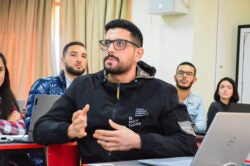 Strong relationships between educators and students, built by recognizing the human stories that each person brings to class, transform young people academically, socially, and emotionally. Because of the impact it can have on students, teaching and learning through relationships is a core value of the graduate teacher preparation program at the American University in Dubai (AUD).
Strong relationships between educators and students, built by recognizing the human stories that each person brings to class, transform young people academically, socially, and emotionally. Because of the impact it can have on students, teaching and learning through relationships is a core value of the graduate teacher preparation program at the American University in Dubai (AUD).
When offered the chance to bring virtual exchange to my classroom at AUD, I pictured it nurturing the relationships we value by enriching classroom discourse with perspectives from across the globe. While our classrooms in Dubai are highly diverse, I saw this as an opportunity to further challenge our beliefs and assumptions, leading us to a deeper appreciation of cultural differences.
What is Connected Classrooms?
Stevens Initiative Connected Classrooms is a training program that pairs faculty from institutions in Morocco or the United Arab Emirates with their peers in the U.S. and prepares them to run and implement a virtual exchange. In summer 2021, I was paired with Dr. Hart Lewis from the University of New Mexico. We identified a common objective between our courses: for the student-teachers in both classrooms to develop a deeper global competence as educators, regardless of their subject area and expertise. Developing global competence can lead to strong relationship-building in the classroom by teaching students to identify personal biases and prejudices, authentically connect with peers from different cultures, and learn to address challenges that arise in multicultural settings.
Thus, the driving questions for this experience became: How can student-teachers use self-reflection to understand and connect with other cultures? What does diversity mean in theory and practice? We named our project – Know Yourself to Know the Other.
Relationships at the Core of Virtual Exchange
From the outset, Dr. Lewis and I realized that for this collaboration to succeed, we needed to create a safe social environment where students could form relationships through conversing with one another, sharing experiences, and participating in activities. This environment needed to be built on trust, empathy, and competence. This is the ethos we communicated to our students in the first synchronous meeting where they were also given an opportunity to build initial connections in breakout groups.
We used Padlet, which is a rich media interactive bulletin board where our students communicated with asynchronous multi-media messages, shared multi-media resources, and engaged in reflections on posted works. Participants were advised to have weekly synchronous meetings. Although weekly meetings proved to be a challenge for some groups due to different time zones, level of commitment to the project, or life circumstances, most groups managed to meet and share evidence of their progress on their specific space on Padlet. When students expressed frustration or disappointment regarding the challenges of connecting, they were mentored on both sides and supported in the problem-solving process.
The resulting postings included project-related literature, pictures and video clips of their meetings, teaching resources, and all sorts of classroom experiences and artifacts. Later, students wrote an individual reflective paper about the experience. They were guided to consider what they learned regarding similarities, differences, assumptions, beliefs that were challenged or validated, and takeaways to their classroom practice.
